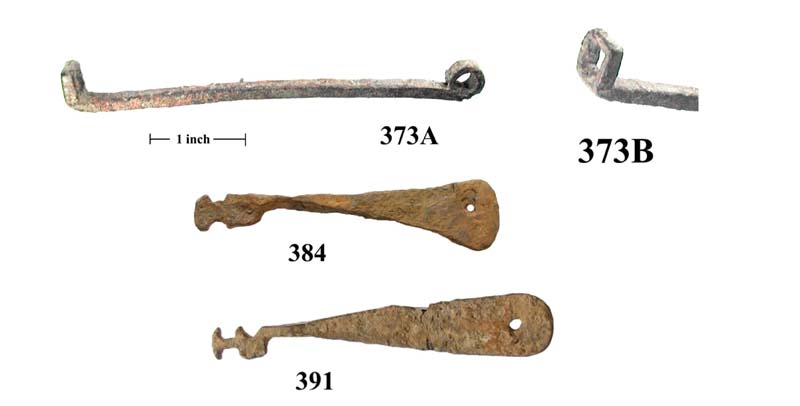


Door Keys & Latch Lifters
Door locks seem to have been made of wood, usually with iron keys, but sometimes of bronze. The locks themselves have not survived, but keys have been found. The latch lifter was a primitive form of key, not really intended for security, but more as a convenience in lifting the inside bolt. A variety of latch lifters was found at Vindolanda.
An interesting sculpture on a sarcophagus was found at Krefeld showing a model of a Roman door with an external lock. This is now in the Deutsche Schloss-und Beschlagemuseum at Velbert.
Key 200 In addition to iron, some bimetallic keys have been found, with bronze handles cast on heavy iron shafts. Figural lion bronze/iron door keys are especially rare and desirable; for example, see the key above from Augusta Raurica (see Riha ref). This is the finest example I've ever seen. My own copy is nice, but lacks the elaborate, richly detailed modeling of this key.
Key 299 This was obviously a custom made assembly, for someone who knew exactly what he wanted. In fact, it was probably made by an in-house smith, as in an isolated villa. Villas in Britain, for example, tended to be completely self-sufficient. Both door key and ring key are iron.
Key 300 Fairly typical iron door key. They tended to be long and heavy, and many survived in spite of centuries of rusting away.
Key 315 Another very nice composite which has survived very well, considering.
Key 366 A key for double security! This is the key, or rather latch lifter, for a primitive type of wooden lock, inserted through the door, rotated and drawn into the bolt. The knife on the other end was of some comfort to the householder returning home through the dangerous streets of the Roman city at night!
Key 378 Quite similar to 366, but with the more conventional loop for hanging.
Key 368 Another elegant composite. It almost seems that while appreciating the appearance of bronze, the Romans distrusted its strength for heavy duty door operation.
Key 376 Drilled rotary key with concretions
Key 379 Huge, massive double ended iron military key. Looks like a key, anyway, but I don't know why it was useful to have two ends, since they appear to be substantially the same. Possibly it also had some secondary use such as a heavy duty fastener, carrier or grappling hook?
Key 381 This heavy bronze key shows considerable shrinkage, caused by improper gating in the casting process.
Key 382 Very heavy and strong, likely for a door but perhaps for an extremely massive chest. Excellent condition for iron.
Key 385 Iron with two parallel rows of three teeth, which is quite a lot for this type
Key 393 Not completely sure of the use for this; alleged to be military and could be for a padlock. That side notch looks like it might be for spring compression and the slots for wards.
Key 397 Unusual design, the only one I've seen with a second row of teeth at a right angle.
The purposes of many keys are not clear, and I have no doubt misclassified some. Probably some of the keys in this section are for doors.
Key 303 This is an interesting design, but could not be carried securely. Looks like it was meant to be hung up somewhere.
Key 314 This is one of my favorites: heavy, chunky, geometric.
Keys 213, 260, 261, 275 The iron key section, part 1 We can't even guess the original ratio of iron to bronze keys that were produced, but enough iron keys have survived to show that they were in common use. As a class, they seem much less ornate, and I suspect that they were cheaper. Functional, but not much prestige here!
Keys 202,214,259,321 Iron keys, part 2
Key 325 So far I haven't been able to think of a reason for the strange design of this one. It is unusually thick, and has a section of iron about 0.1" thick sandwiched between bronze top and bottom. No doubt the thickness of the shank is to allow it to be poured around an iron core without cracking, buy why should the bit section be continued in bronze?
Door keys
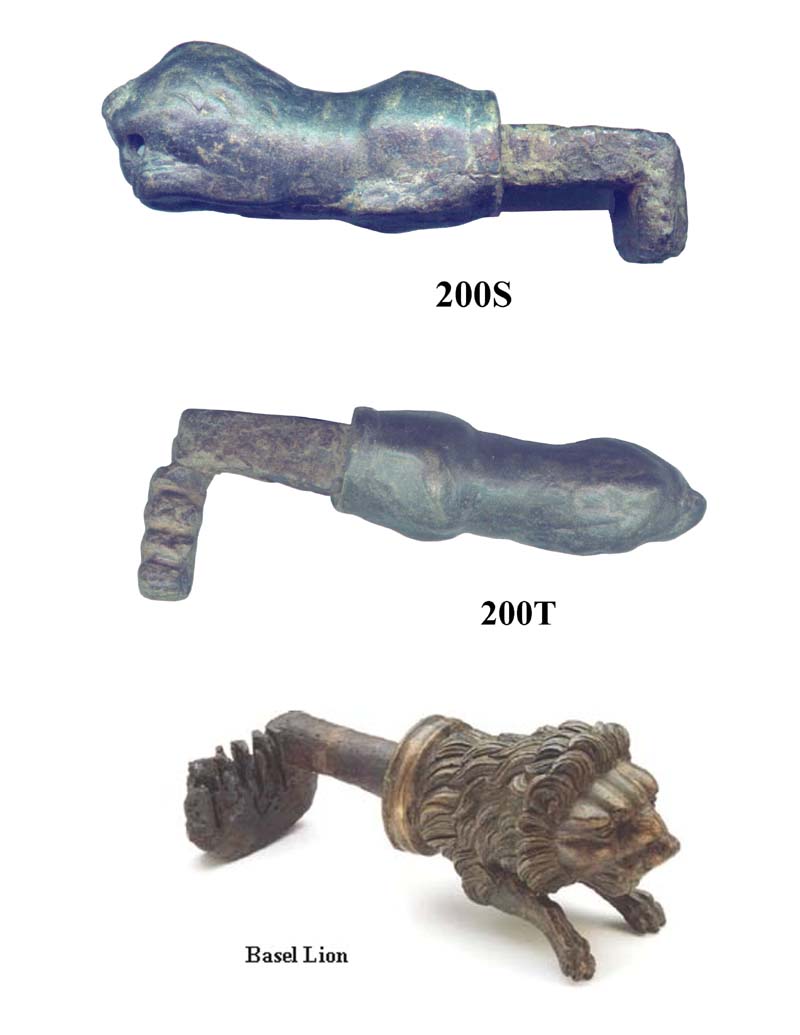
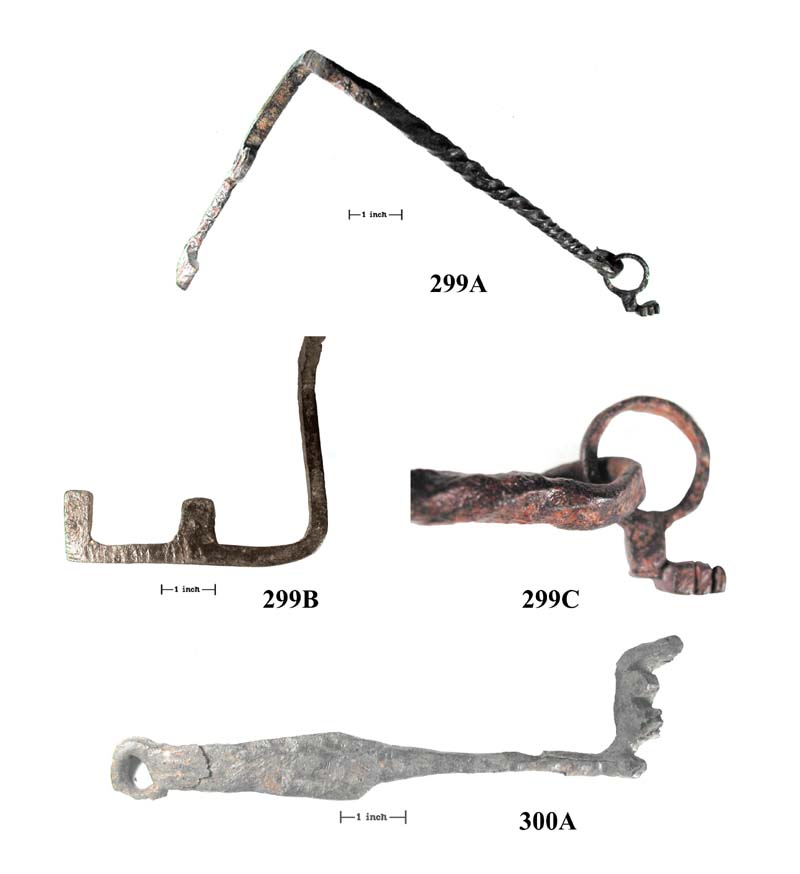
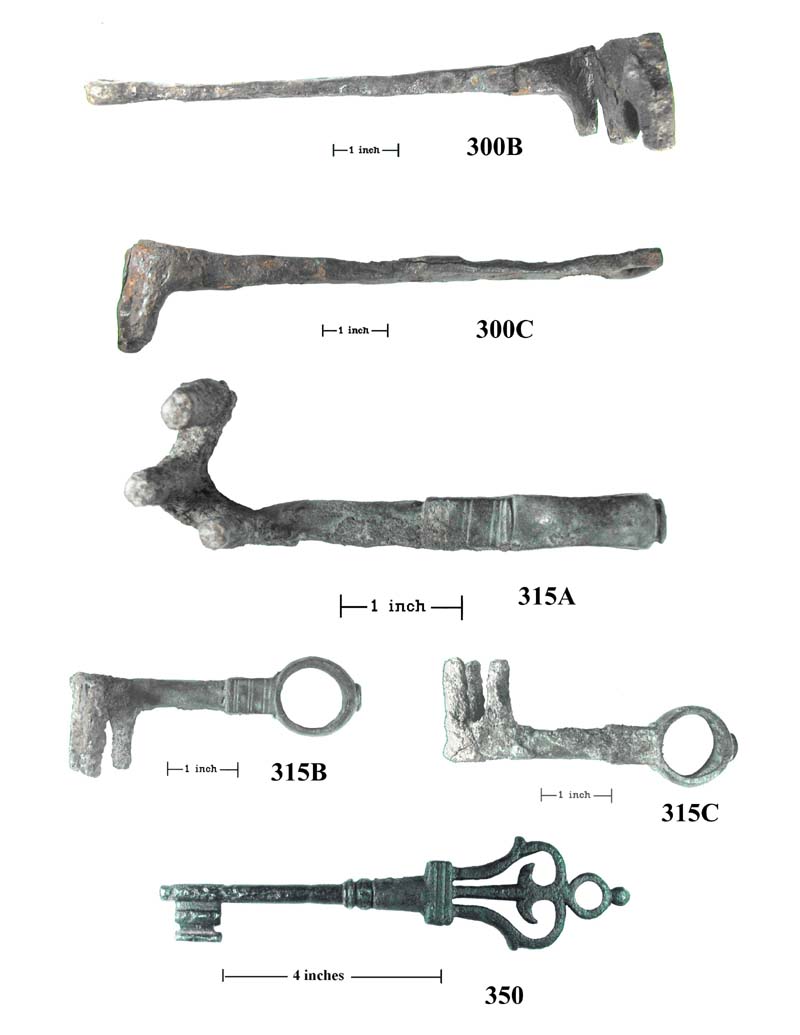

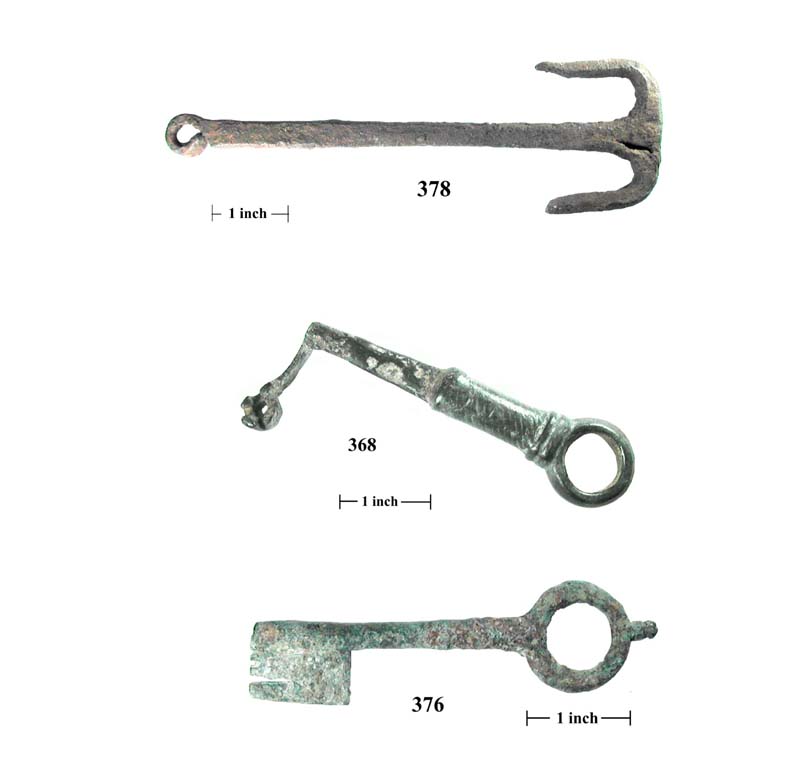

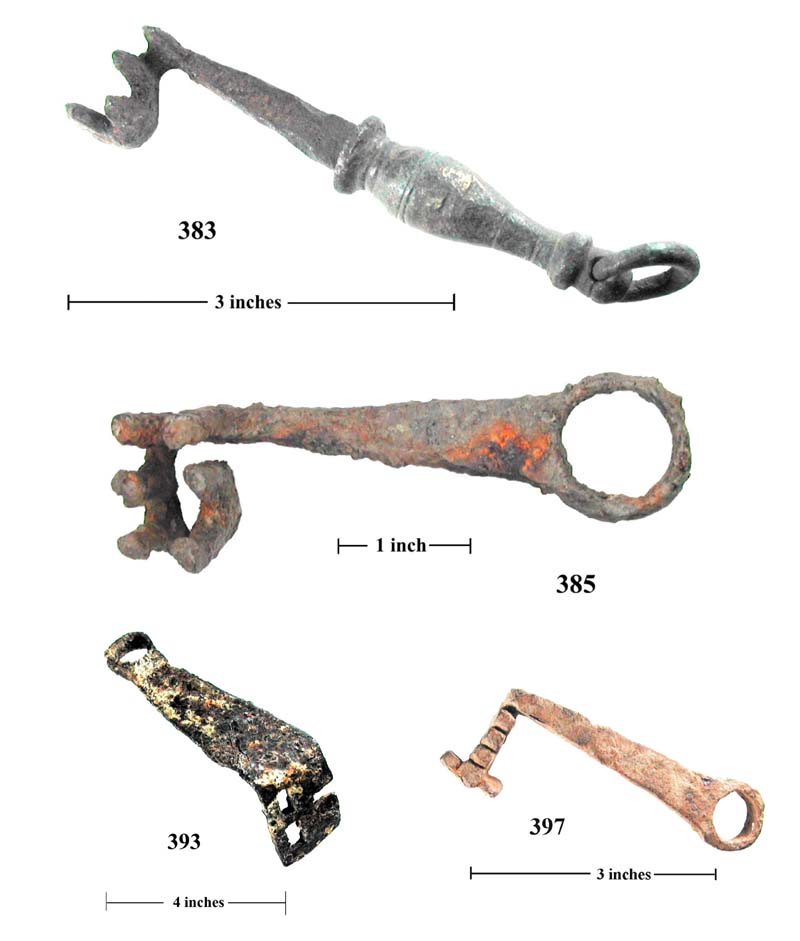
Long keys
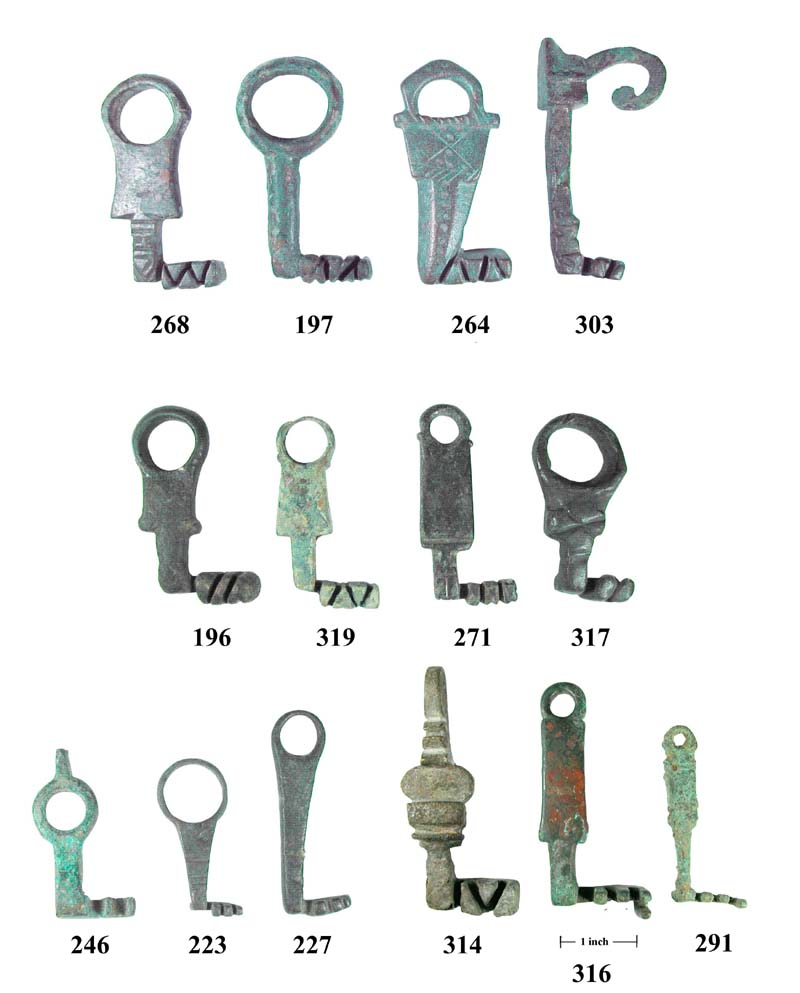
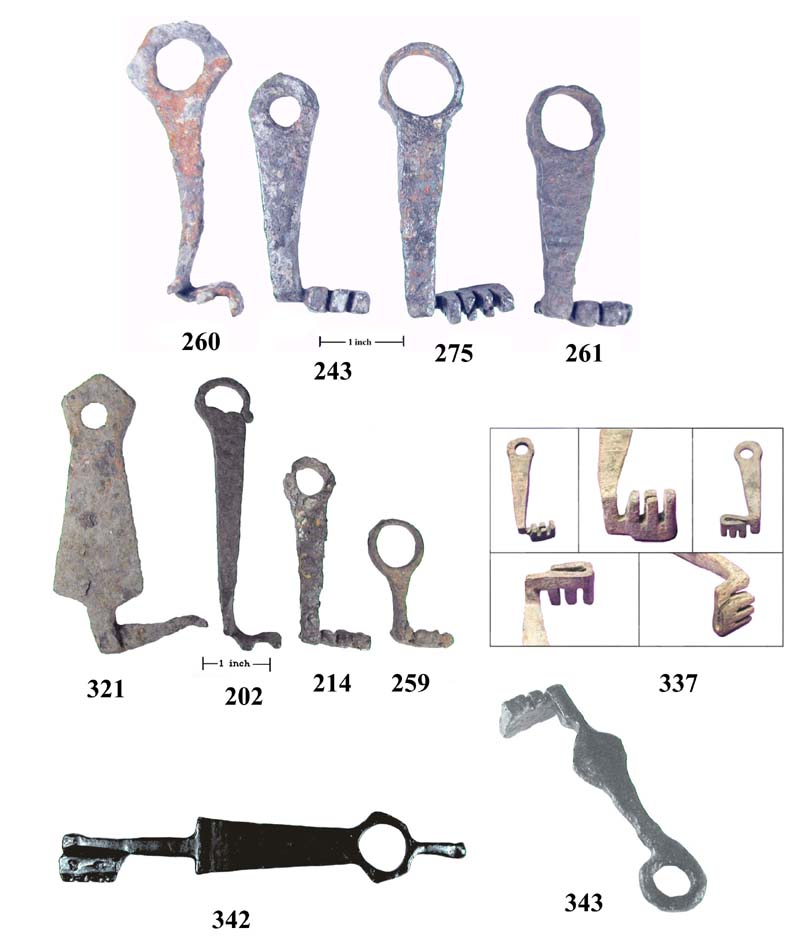
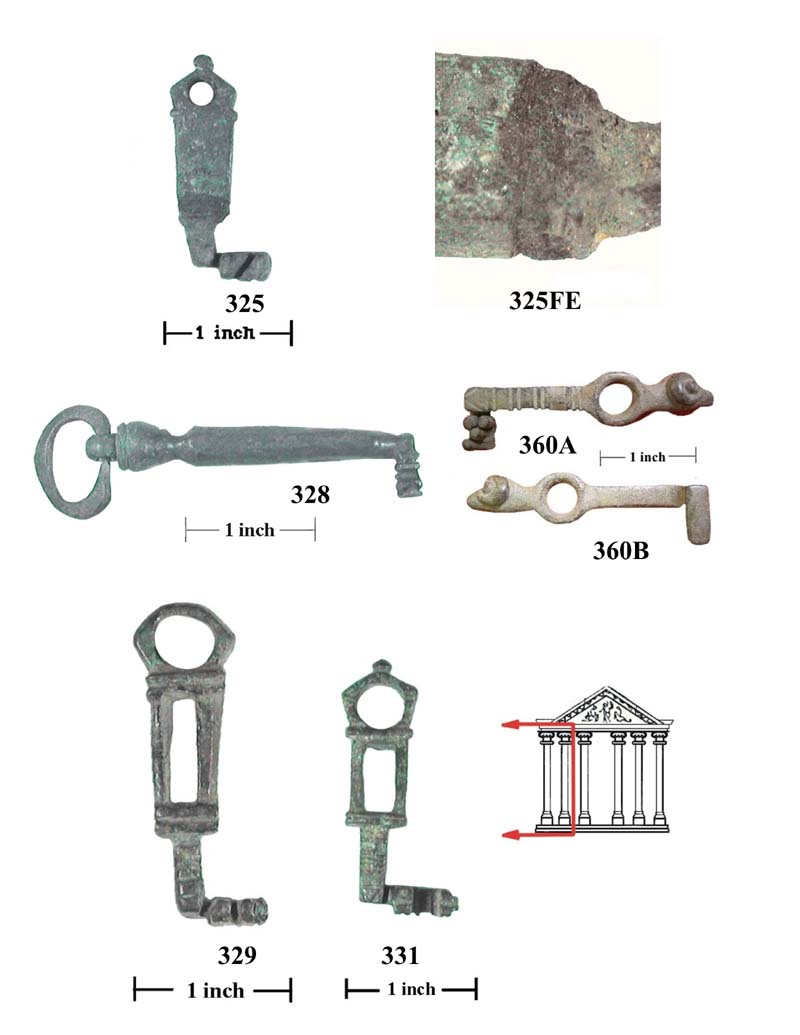
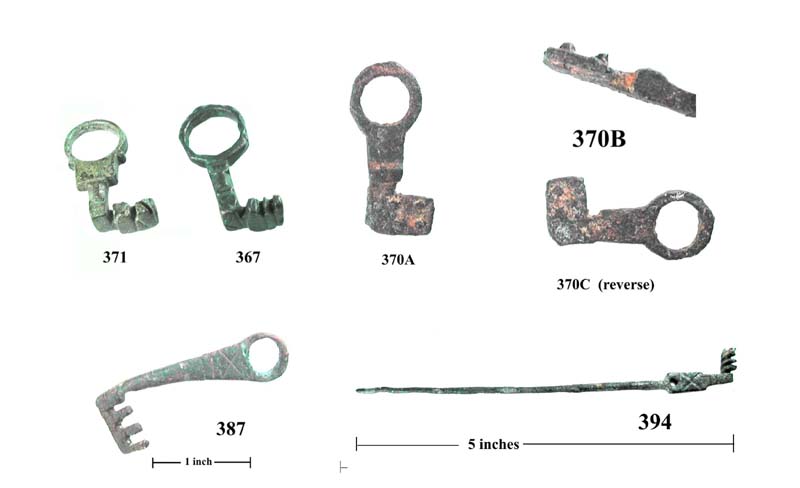
Key 328 There are some unusual things about this one. For one, it's a folding key, first of this size I've seen. Also, the bits are opposite to those of all the bit keys shown here. It's alleged to be Byzantine, maybe that has something to do with it.
Keys 329,331 The Romans, like most everyone else up until very recent times, thought that everyday objects should be enhanced with as much decoration as could be afforded, or function would allow. We still haven't entirely abandoned that feeling, have we? The designs of Roman artifacts often included religious and architectural elements; remember the temple-furnace shown in the introduction? Keys 329 and 331 manage to work part of a temple facade into the design! I've seen keys in which this temple motif was carried out very elaborately. Figural Roman objects are very desirable, and command premium prices.
Key 337 This is my smallest long format pin tumbler key, 1.460". It's unusual in that the pins were made by folding over the material, either the wax model or the bronze casting. Hard to say which, but I think it was in the wax. No idea why the fabricator would do such a thing. Clever, but I note that the bow is not very well done.
Key 342 Undoubtedly Roman, but a rotary key made to fit plate wards. An unusual configuration for an unusual lock, in my experience.
Key 343 Large, functional iron key, remarkable mostly for the curious flattened area along the shank. It was just smashed flat during fabrication, but I've no idea why this was done.
Key 350 Unusually large rotary key, with intact iron. Typical bow design for large bimetallic keys.
Key 360 Delightful figural with a ram head, a battering ram on a very tiny scale.
Keys 367, 371 Noticed that these have a similar decoration, cast-in bevels on either side of the shank. Otherwise, simply very nice examples of not-quite ring keys. Wearing them on fingers would be uncomfortable.
Key 370 This is a type of long-format key that is not rare, but not so common either. It is iron and strictly utilitarian. The pins are made separately and pressed into holes punched into the key blank. One protrudes a bit from the back, as I tried to show in figure 370B. I haven't seen any bolt that such a key might fit.
Key 387 Looks like a door key, but is much too small.
Key 394 Very interesting dual purpose key. I think it was used as a hairpin, both ornamental and a neat solution for the problem of carrying. Although tiny, the key itself is quite detailed, and I believe was functional in a casket lock
Ring keys are the most abundant and popular type that are collected today. We have been told often enough that Roman ring keys were worn on the finger. It could certainly have been done in most cases, but I think that the ring was primarily a device for hanging. Sometime I must try wearing a ring key for a day. If worn so that the shank and bits were on the outside of the finger, I suspect it would catch on everything and flop around something fierce! If worn on the inside of the finger, I can picture two citizens shaking hands and locking keys! Or did they shake hands in those days? No, but they did clasp hands on certain important occasions. Many ring keys are known which are too small for any human finger. I believe that most often, ring keys were hung on thongs around the neck or suspended from a girdle. There is physical evidence (muzarp) that keys were sometimes attached to a belt.
Normal tumbler ring keys
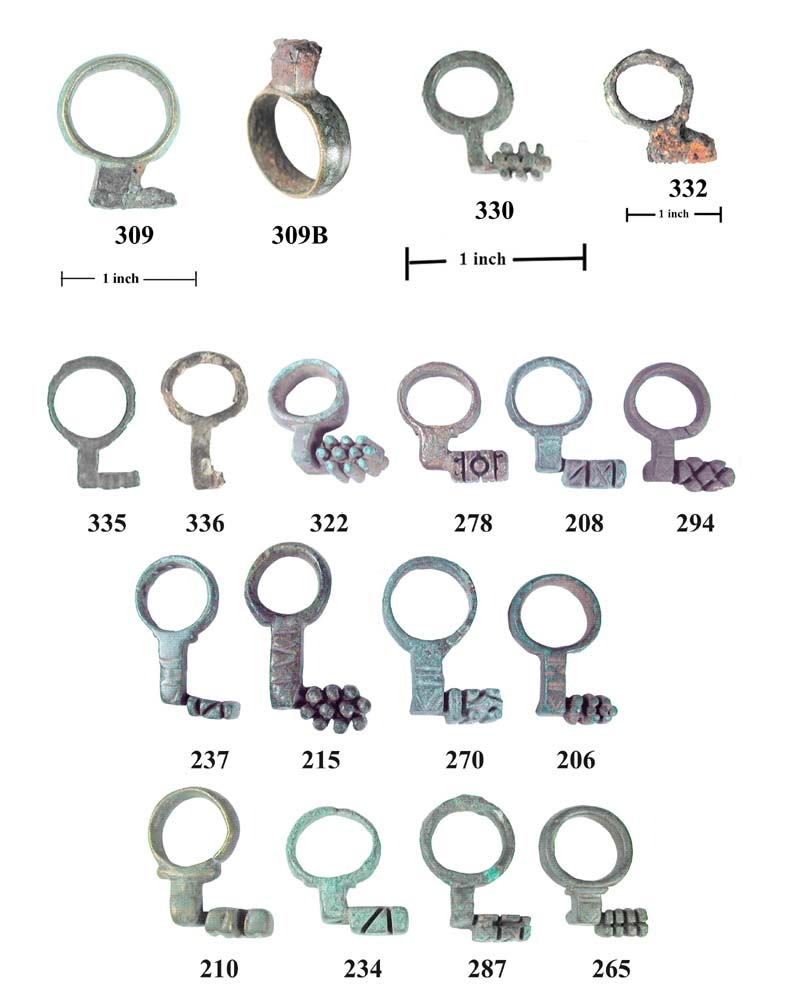
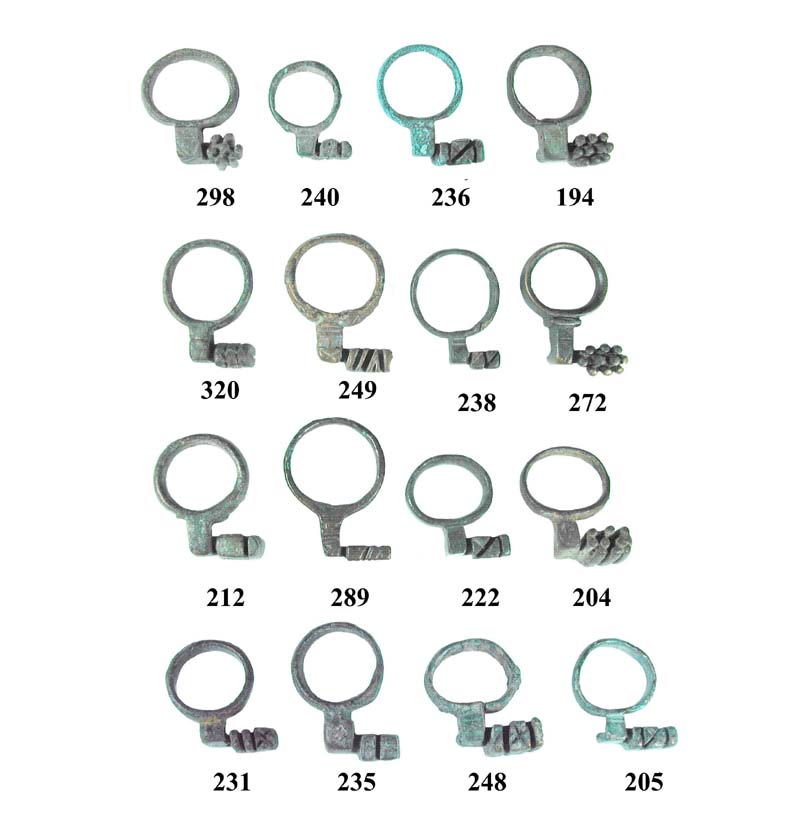
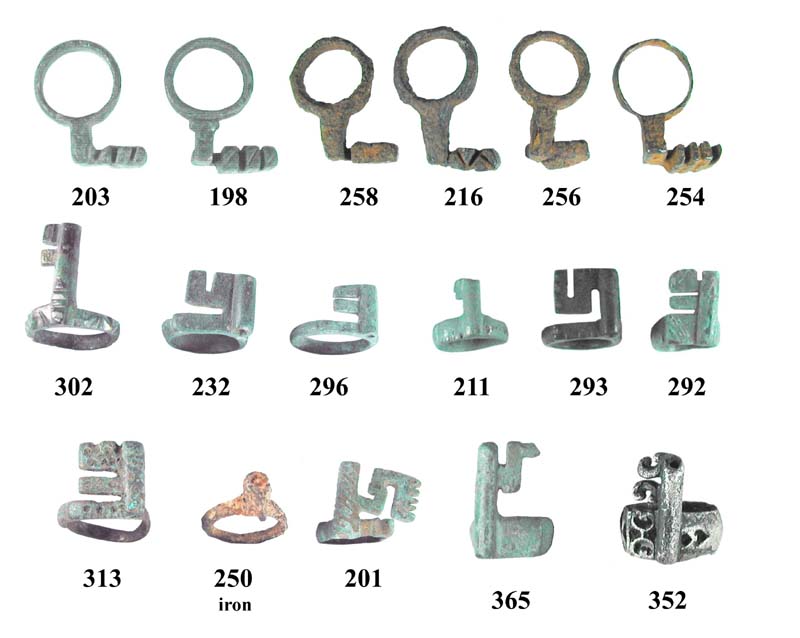
Shank up tumbler ring keys
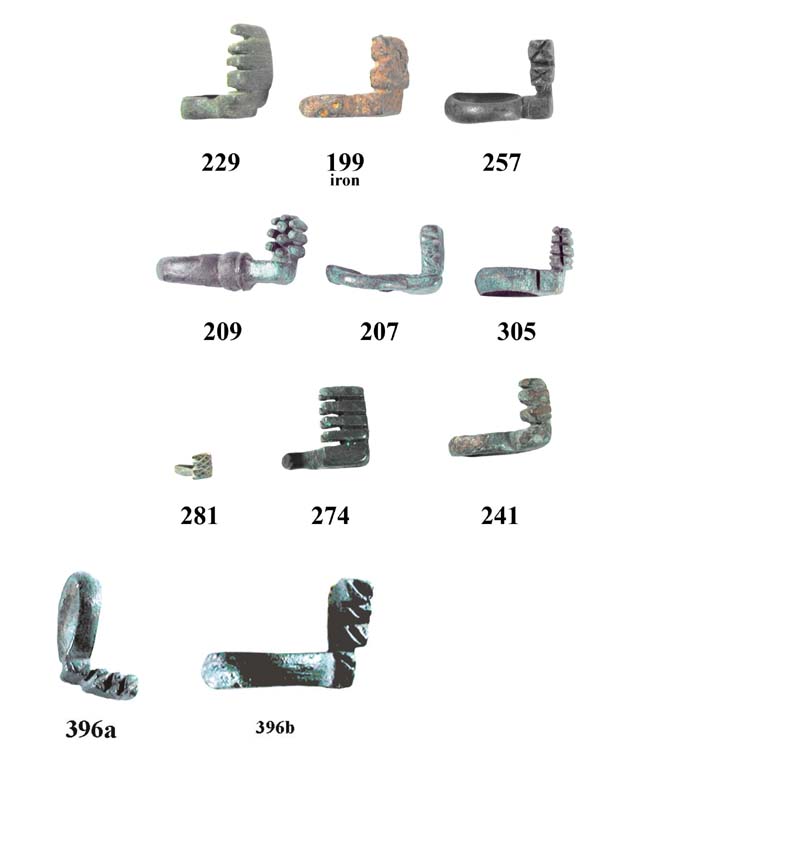
There may be an organizational scheme for Roman keys somewhere that I haven't yet found. Therefore, to bring some sort of order into the chaos of ring keys, I've arranged my own in the following categories:
1. Normal tumbler ring, shank in the same plane as the ring
2. Shank up tumbler ring, shank perpendicular to the plane of the ring
3. Rotary ring
4. Folding ring
5. Warded ring
Normal tumbler ring
This is a selection of the ordinary or "standard" ring keys that are available at this time. There may be duplicates somewhere in the world, but each of these is an individual, differing slightly from all the others. Comparison of such keys with bolts that have been found shows that not all the decorative cuts and slots in the bits were used in the mechanism. They were partly for display and prestige.
Keys 309, 388 Despite their nondescript appearance, these are rare finds, bimetallic ring keys. 309 is brass/iron and 388 is silver/iron. Much of the iron has been corroded away, but we can see the joints where the metal was poured into the iron bit section. If there were one available in very poor condition, it would be interesting and worth while to section it to determine exactly how the join was made. Nondestructive testing would be preferred, of course. However, I really think key rings that display only stubs where the bits should be are just bimetallics with the iron all gone. But how did they shape that little well in the iron into which the brass or silver was poured?
Key 392 Another composite bronze/iron key, with unusually well preserved iron part, and a nice circular pin design as well.
Keys 258, 216, 256, 254 All are iron
Key 335 Another iron key, exceptionally well preserved
Key 336 This one is made of lead! The bitting has been broken off, apparently during excavation. There is cracking and splitting and many pits filled with lead oxide, but the survival is pretty good. Why lead? I thought it must be a toy or experiment of some sort, but felt better about it when I came across the following passage (LEG II AVG), "rings for fingers or thumbs were worn by men and women, sometimes several at a time. They were made from gold, silver, bronze, iron, lead or glass. Some have a small key attached." Well, I've seen glass bracelets but never a glass ring, and a mechanical device made of lead seems like a bad idea. Still, somebody made it.
Shank up tumbler ring
These seem to have been less popular, judging from the number now available. Why? If they were actually worn on a finger, they would be much less awkward.
Key 281 Very tiny, gold plated. No idea why such a thing would be made!
Key 396 This was represented as a child's ring key because of the small diameter, 0.565".
Rotary ring
Key 302 Very attractive specimen, with a faceted band.
Key 313 Decorated with cast-in indentations.
Key 352 Silver, and quite ornate. It would work, all right, but I have to suspect that it was primarily made to be worn as an article of jewelry.
Key 377 Note that this pretty key, aside from not being bent and made of bronze rather than silver, is an exact duplicate of 352.
Folding ring
All the Byzantine ring keys shown from the Menil collection (Vikan, 1980) are folding. I would like to assume that the converse is true: that all folding ring keys are Byzantine, but the weak provenience of keys in that collection doesn't quite allow that.
I must agree with most commentators that the purpose of folding was convenience in wearing on a finger, if the owner elected to do so. However, I personally feel that a hinged ring flopping around on one's finger would be a considerable inconvenience, and I don't think the question is settled yet. All but 247 are also barrel keys
Keys 230, 247 Two of the most elaborate ring keys I have are also folding. This is in accord with the Byzantine style.
Key 230 origin not stated.
Key 247 is from "the Balkans"
Key 253 is iron and quite plain. Alleged from Syria
Key 266 also alleged to have been found in Syria
Key 338 is also iron, but sufficiently corroded that it will never fold again. Origin not stated
Key 347 is ideally designed for suspension and impossible to wear as a ring. There would have been nothing to gain by the folding feature and I think in this case it was fashionable rather than useful. I suggest that since such keys were normally folding at the time, this one was made that way by custom rather than for usefulness.
Key 353 is from Lincolnshire, which would make a Byzantine origin unlikely, though not impossible. The outer ring surface is octagonal. Iron.
Key 390 This is really getting a bit too large to wear on a finger, I think
Key 395 I suspect that the last day of service for this ring was somewhat traumatic, but it has achieved a lovely final condition. Those coils are actually wire, not cast-in. They are somehow wedged into that fitting at the top.
Warded ring
Warded ring keys are supremely attractive to collectors because of the variety of intricate designs. Here again, I suspect that these were to some degree prestige items, and that not all that maze-like metal area was functional. They have been called "matron keys", but I'm not yet convinced. (see W. Jones and S. Bury)
Key 233 This is the most ornate of warded ring keys that I've seen, and the only one to bear an inscription (inverted in this image, I think). I'm embarrassed to admit that I cannot translate it Anyone?
Key 232 I expect little Marcus got spanked for stepping on this one!
Keys 304, 308 Don't know quite what to make of these, very delicate.
Keys 267, 333 Of course one is tempted to think of these as Christian symbol rings, but they're attractive just as designs.
Keys 345, 346 A little more decoration than normal
Key 364 Very odd design; I think made for decoration rather than function.
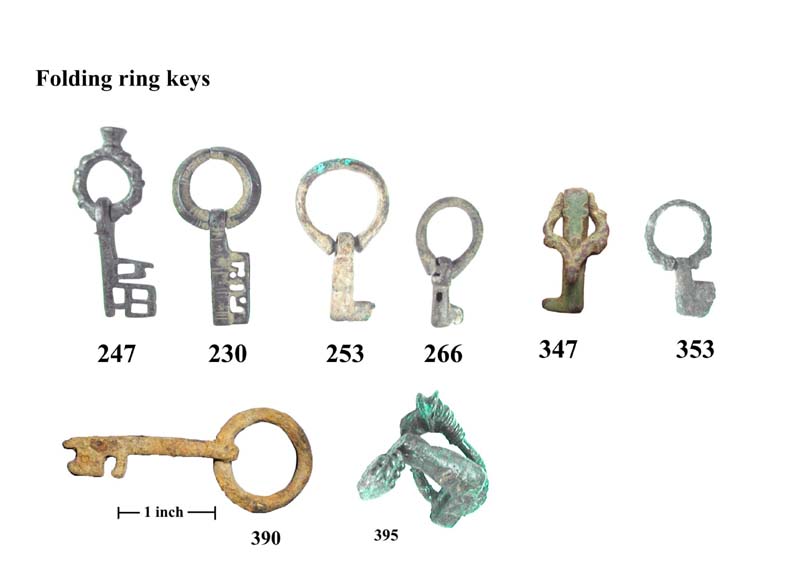
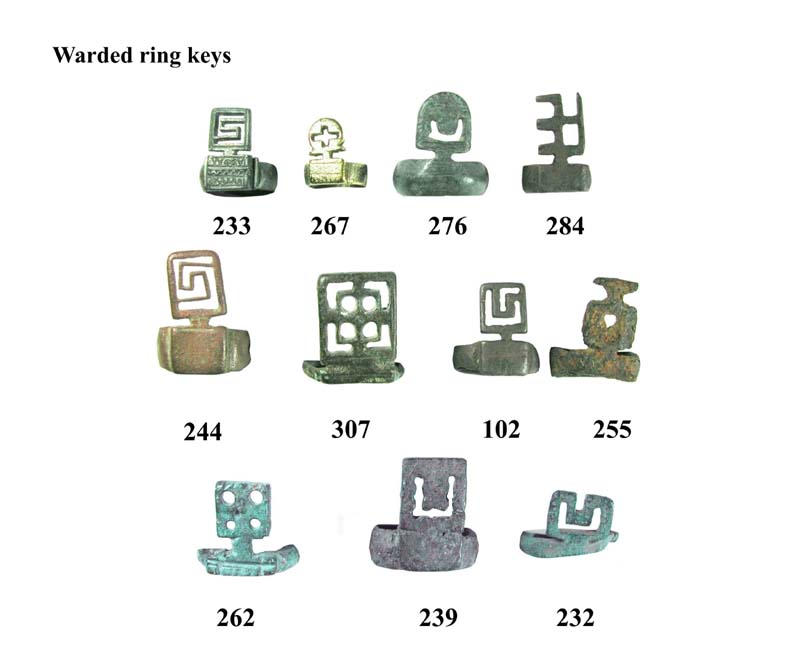
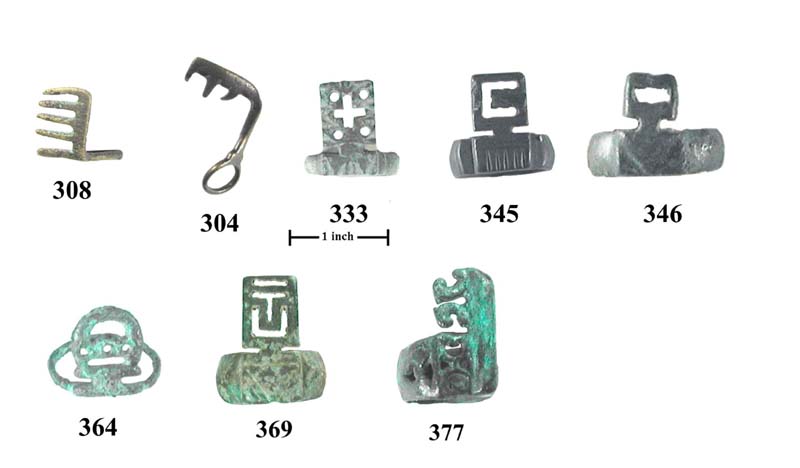
Rotary long keys
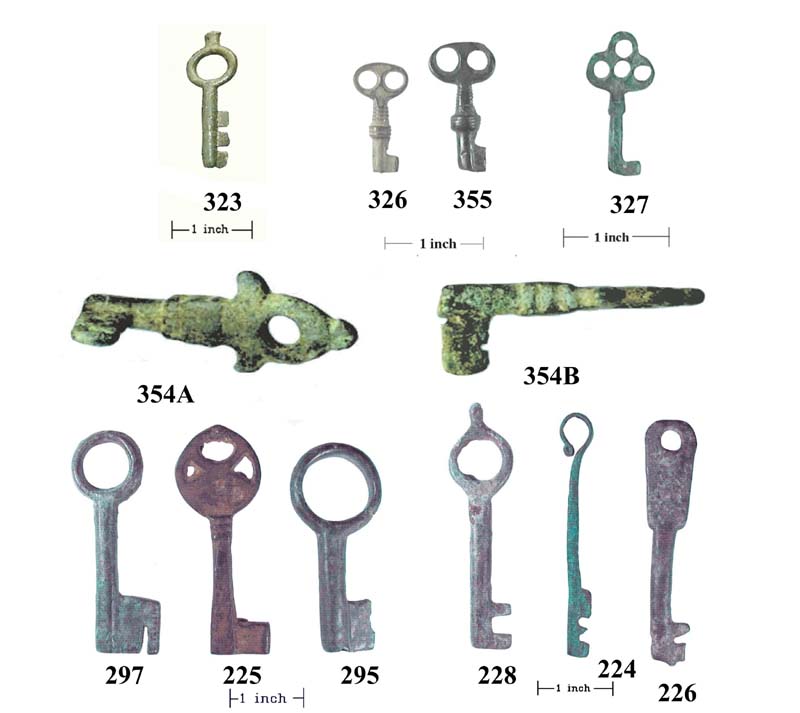
Rotary keys Locks using rotary keys were first developed by the Romans. The keys are instantly recognizable to us; they resemble those in common use until the last century. I'm reproducing here a drawing from Biasiotti that is the clearest I've seen of the functioning of a Roman lock operated by a rotary key. Rotary keys were also usually warded.
Key 225 Despite the iron stains, this is a bronze key
Key 228 Many keys are found with this little nib on top. Zara suggests that the purpose of this is to push or turn away a keyhole guard.
Key 224 The "shepherd's crook" design. This one is bronze, but the design is also found in iron keys
Key 306 In addition to its size, this one is remarkable in that it has a carefuly made chain attached to a leaf shaped plate, somewhat like a key tag. This is just like the tag shown before in chest lock group 4940.
Keys 326, 354 Stylish little keys with concave bow loops and barrel ornamentation. They're virtually identical except for a slight difference in size. Alleged to be Byzantine.
Key 327 Byzantine
Key 356 I guess this delightful little figural qualifies as a cartoon. I've seen only one other like it.
Key 359 Extraordinarily chunky and heavy, built to last!
Key 365 I found this key interesting because the bitting is so remarkably similar to that of keys made in very recent times. I'm sure there are still locks around that could be opened by this key.
Padlock Slide Keys
Slide keys were used to compress the springs in padlocks with long cases and barbed spring mechanisms. Those in this collection are of iron. Iron slide keys are surprisingly rare, no doubt because of corrosion in the ground. They are entirely functional: undecorated and crudely made, with a simple form that is little different from those used in modern times.
Key 361 As has been pointed out earlier in the discussion of padlocks, this key is eminently suited for opening a lock with a keyhole and open slot in the top. The right angle is necessary because a vertical key shaft would be blocked by the shackle.
Key 362 Made for a keyhole at the rear end of the lock. This was forged from a strip of iron, showing evidence of folding over at the suspension hole and in the front section of the shaft. The I-shaped front end was more carefully made, probably by filing.
Key 373 This was purchased as a "Roman tool", and so it is, a tool for opening a barbed spring padlock. The lock must have been unusual though, very wide and narrow with a relatively small spring assembly.
Keys 384, 391 The shapes of these keys show that there were wards to be bypassed.
Rotary long keys, continued
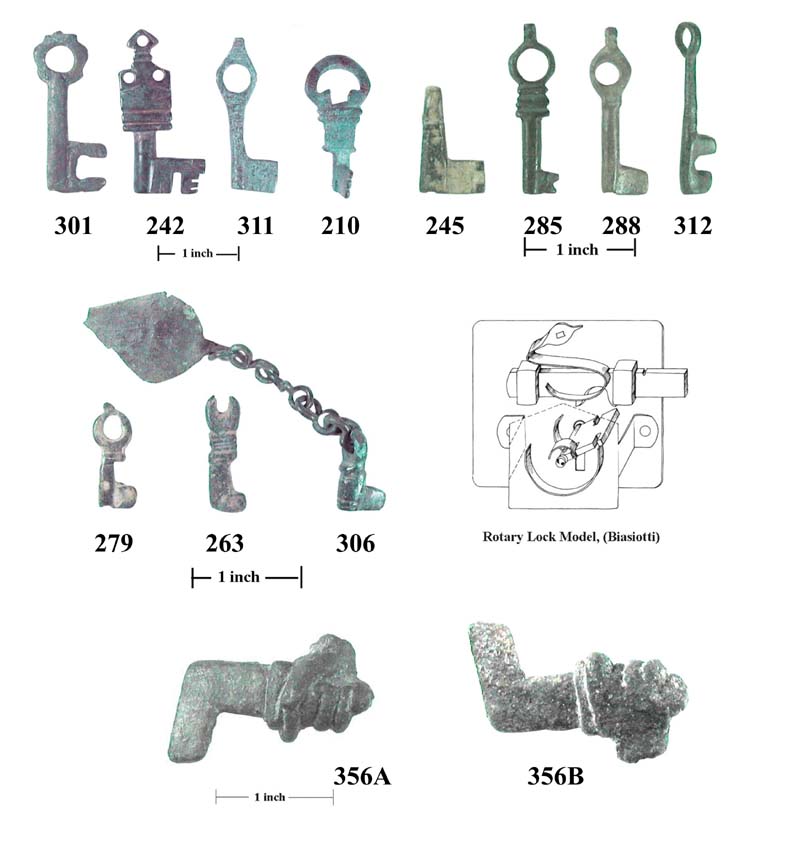
Padlock slide keys

